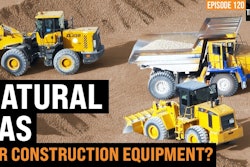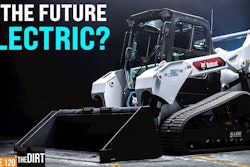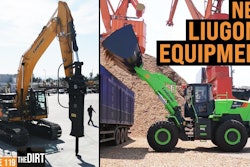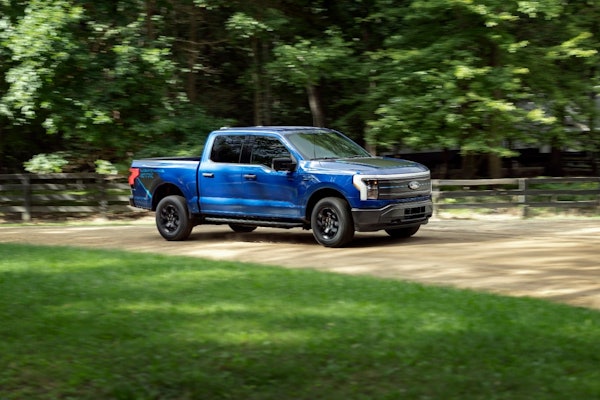The Track-O Minidozer is a small but mighty remote-control device for working in places where you wouldn’t want to send workers.
On this episode of The Dirt, we hear from Jean-Yves Bacle, sales director for Movex Innovations, the manufacturer of the Minidozer. He outlines how the little crawler came into being and some of its many uses, including for the construction industry.
Along with its small size, it runs on lithium-ion batteries, making it useful on indoor jobs or in places where diesel emissions would be harmful to workers. But it also has some heavy-duty tracks for traveling in rough outdoor terrain. Its 22-inch height and width of 28 or 48 inches wide, depending on the model, adds to its versatility.
Movex Innovations has also extended its remote-control, battery-powered technology to other types of small work devices for hauling materials and lifting. They can even climb stairs. The company finds that the uses for its products continue to expand as more people find out about them.
To get a closeup view of the Minidozer and Movex’s other remote-control equipment, check out the latest episode of The Dirt.
Equipment World serves up weekly videos on the latest in construction equipment, work trucks and pickup trucks – everything contractors need to get their work done. Subscribe and visit us at equipmentworld.com!
In This Episode:
00:00 - Why the Mini-Dozer Is So Cool
00:37 - History of Movex
01:20 - Mini-Dozer Application #1: Aluminum Smelting
03:38 - Mini-Dozer Application #2: Mining
05:18 - Mini-Dozer Application #3: Box Culverts
06:40 - Mini-Dozer Application #4: Battery Recycling
07:18 - Specs and Operation of the Mini-Dozer
11:42 - Autonomous Mini-Dozers
12:45 - Stair Climbing and Off-Road Tracked Vehicles
13:51 - Portable and Off-Road Cranes
17:06 - Diesel & Gas vs. Electric Operating Costs
19:16 - Final Thoughts
Bryan Furnace (00:00):
Today we're here to show you one of those toys you didn't know existed, but now that you see it, you need to have it. We're talking about the MINIDOZER. It is an awesome little device that you can use to clean out under conveyors, you can use it to crane around stuff, you can use it to just carry stuff. It goes upstairs, it can go down in box culverts. This thing is really versatile and it's quite a little powerhouse. But enough about what I think about it, let's go to the interview.
(00:37):
Most of our audience is going to be in the same boat as me and have never heard of the MINIDOZER. So can we start at just a high level? Give us an overview of the MINIDOZER, what it does and the background on what you guys do as a company?
Jean-Yves Bacle (00:48):
Certainly. Movex Innovation, we're located in Shawinigan, Québec, which is halfway between Montreal and Québec, two old hockey rivalries. And we've been manufacturing since 2001, electric track vehicles with remote capability, with the objective of increasing the operator's safety and wellbeing. In addition to that, prepare and start the shift towards electric vehicles instead of the ICE, internal combustion engine, and to increase productivity of our customers. The MINIDOZER, or Mini-Loaders as some would call it, was initially developed in 2007, 2008 when we were approached by one of the global mining company called Rio Tinto who just made the acquisition of Alcan, which is the big Canadian aluminum smelters. And the program was a continuous improvement program to change the use of diesel engines which are located and the pot-line basement. Pot-line basement is where you actually feed the high voltage, high amperage current to each individual pot to do the what they call aluminum electrolysis.
(01:59):
Very, very harsh environment, because first of all, you're talking about temperatures ranging from 100 degrees Fahrenheit up to 150, and as high as 170, working a very harsh environment because we're talking about aluminum particles, which are very hard, very abrasive. In addition to that, the unit had to be designed to withstand high electromagnetic fields as much as 500, and even more, gauss. So we developed from scratch an electric track vehicle with a joystick controller, allowing the operators in the aluminum smelters to safely operate those dozers and loaders in the confined pot-line basement areas.
Bryan Furnace (02:44):
Wow. And it occurs to me as you're going through the construction and the design process, you guys call it the MINIDOZER, but it sounds like you built a mini tank. That thing can handle some serious conditions.
Jean-Yves Bacle (02:54):
It does. The actual weight of the MINIDOZER at 48 is about 3,300 pounds. We have a lighter version, which is the M-27, which is 27 inch wide versus 48 inch wide, it is about 26, 2,700 pounds. And we have another unit, what we call the 39, which is 39 inch, which are about 3,000. So they're very low profile vehicles. They have adjustable rear sections, allowing you to have ground clearance as you wish, and the maximum height of 29 inches and the minimum height of 22 inches. So this gives the customer flexibility to operate in different environments with different ground clearance and with different height adjustments as well.
Bryan Furnace (03:37):
So outside of the aluminum smelting industry, what other industries can benefit and where have you seen the MINIDOZER put to use?
Jean-Yves Bacle (03:45):
That's an excellent question. Obviously after developing this for the aluminum smelters, which was probably the most stringent and difficult environment, we decide to expand addressable markets by developing mining versions of the MINIDOZERs, which would be used in working and cleaning operation underneath conveyor belts within ore processing plant. When they mine, they have to crush the mineral, they have to separate and do concentrate. So those big milling plants have multiple conveyors, very hard access areas. So the MINIDOZER has been utilized in multiple mines around the world to clean underneath the conveyor belts because, a, it allows them to do the cleanup without stopping the mill, which is a big production, b, you don't want to have any operators with shovels near a conveyor belt because we're transporting big rocks.
(04:42):
So this allows them to be giving the operators a safe environment. It allows them to eliminate downtime, clean the conveyor belts while the conveyor belt is still in operation. So we've been exporting MINIDOZER and loaders in mining in South America in countries such as Peru and Chile. We also have customers across Canada, and more recently we're going to be shipping one unit to Kinross Gold in Fairbanks, Alaska.
Bryan Furnace (05:12):
Wow, very cool.
Jean-Yves Bacle (05:14):
In addition to that, that was started in 2010 and in 2015 we had a request from a large city, City of North Las Vegas, who wanted to clean their box culverts or large tunnels. This is where you gather the storm water and you recuperate the storm water, and obviously the type of soil that you have in Nevada as well as Arizona, New Mexico, and Texas, these are not permeable soil so that when it rains, the water accumulates. And then when it goes into the water infrastructure, it transports sedimentation. And if these box culverts, pipes, or tunnels are not cleaned on a regular basis, and as the climate has been changing over the last 50 years, the water storms are much more severe, obviously you have situations of floods. So cities, department of transport, have conducted testing and we have multiple customers across the United States, which includes states of Arizona, Texas, even the military, that are using our electric track vehicles for cleaning box culverts.
(06:26):
We also rent to our customers, multiple contractors have short term projects. They have to conduct for customers such as cities or department of transport, and these units are available for short term rentals. In addition to that, we have all expanded the use of the MINIDOZERs in the recycling centers, and more specifically, we're shipping a unit to a battery recycling company which has to use our MINIDOZERs to work closely to the furnace while it melt down and recuperate materials from batteries. As we're shifting towards electric mobility, more and more batteries will be used in car and transportation. So the recycling part of the industry is looking for solutions which allows them to do the work and do the work safely with our MINIDOZERs and Mini-Loaders.
Bryan Furnace (07:17):
Interesting. So let's get into the actual operation of the machine for a second. What runtime are you getting off of your battery packs currently and then what recharge time do you have on the back end of that?
Jean-Yves Bacle (08:47):
To take for example, our MINIDOZER M-48 has two battery sets. Each individual battery set are four batteries, which are AGM, maintenance free, they're glass filled polymers, and they're interconnected by the electric harness and mounted on the plate. Two sets for the M-48. On a standard speed operation of 66 feet a minute, the autonomy is between eight and nine hours of operation.
(09:17):
We do have a new digital platform for MINIDOZER, allowing them to go to higher speed. A high speed gives you the option to run speeds as much as 200 feet a minute. The autonomy obviously is reduced because the higher, the faster you go, the more amperage you consume. But the design of our vehicle is such that you can swap the batteries by simply opening the rear section and with a simple device such as a lift truck, forklift, lift the battery set and swap the two battery sets for a fully recharged, it's a five to 10 minute operation, and there you go for another five to six hours of autonomy, if you got the high speed option.
(09:59):
The high speed option is a programmable speed, allowing you to adjust the speed as you wish. In certain instances, long distance traveling where required a high speed, but when you operate inside a box culvert, it's preferable to not to go that much fast. We also have developed for this market for the box culvert high definition camera systems. So that allows customers such as cities, department of transports and contractors, to stand outside with the remote control joystick and have perfect picture of what's happening inside the box culvert. And the signal boosting system allows you to reach up between 200 to 250 feet per entry, meaning you could cover a total box culvert of 500 feet. For bigger, longer box culverts, we could supply also signal boosters as well.
Bryan Furnace (10:53):
Interesting. So you've got a pretty good range on your remote. This isn't something that a hundred feet in, you're losing signal and you're struggling to know what's going on.
Jean-Yves Bacle (11:00):
Exactly. Our machines have been tested inside concrete tunnels such as box culverts or pipes. The range would be 250 to 250 feet per entry. On an open field, the range of the remote wireless controller, which has two joysticks, one of which is for to operate the machine, forward, steering, backward, and the other joystick is for controlling the hydraulic system, meaning the lifting arm and the bucket. The range could go as much as a thousand to 1,200 feet, but we do not recommend that because it's obvious the operator has to see what it does. But that's the range. And we have customers that have starting to develop autonomous version of the MINIDOZERs with artificial intelligence and camera and GPS. So the next wave of the future will be automatic guided or what they call unmanned guided vehicles.
Bryan Furnace (11:56):
Very interesting. This is one of my favorite parts of the industry is just how much technology is starting to come in and change the way we think about doing a menial task like cleaning under conveyors. That's something that really we shouldn't be tying up an individual and a machine to do, whereas if you could have two or three of these MINIDOZERs autonomously going and doing that, that's a tremendous savings.
Jean-Yves Bacle (12:18):
Plus the fact that there's no real danger because there's not many people walking around those areas. These are fixed assets. So mapping the actual location of the conveyor belts or the infrastructure box culvert is not a tedious exercise. So having those MINIDOZERs operate as iRobots is eventually in the plan on the short to medium term. There's no doubt about that.
Bryan Furnace (12:44):
So I want to shift gears a little bit because as I've done some more research before the interview, I've seen you guys also have these units set up with a crane and I've seen them primarily used for setting transformers on the electrical side of things.
Jean-Yves Bacle (12:56):
Exactly.
Bryan Furnace (12:56):
Can you talk a bit about the carry characteristics? What weight can these things carry and then also the craning abilities.
Jean-Yves Bacle (13:03):
In addition to the loaders, we build track vehicles for climbing stairs, transporting equipment on stairs such as mass transits or for construction. In addition to our stair climbing and our loaders, we do have an off-road Cross-Country. The off-road Cross-Country was initially developed for utilities to actually get and remove and replace power transformer which are pole mounted. Typically, these would be off-road conditions, so the Cross-Country would operate in those type environments, which can include snow, hills, mud, water, whatever, they're all-terrain vehicles. And they were able and designed to transport large power transformer to the exact location. The Cross-Country was then added with additional features such as cranes.
(13:56):
The first requirement came from a oil refinery company called Valero. Valero had a big oil refinery in the Québec City area, and as one can imagine, inside a refinery you have all kinds of electric equipment, pipes, and it's very hard to access. So they needed to have a very narrow platform which can pick and carry payloads while having a telescopic crane to go in very confined areas, remove an electric motor or pump, and then retrieve it and replace it while operating in the very constrained, very narrow area. So that's how we developed our first pick-and-carry Cross-Country telescopic crane.
(14:43):
In addition to that market, we've expanded also the pick-and-carry Cross-Country 272 other markets such as construction, especially for narrow areas where contractors can ill afford to rent an enormous crane, can simply use this nifty, very narrow, high capability pick-and-carry crane and do the work. We've also expanded our markets by selling those units in the mining industry to do the maintenance inside a milling plant. We also have supply unit to the pulp and paper industry to do the maintenance of their paper machines as well as other markets.
(15:25):
So we're expanding the addressable market for the Cross-Country pick-and-carry. And what's unique, it's the only vehicle that you can operate and transport a payload. The actual crane is mounted on the frame, a sub frame which is mounted on the machine, and you can pick a load, put it on top of that machine and transport. The capability of transporting the load typically is limited by the actual crane. So in this case the crane can lift and pick a 1,000 pounds at 16 and a half feet or 2,200 pounds at 8.8 feet. So the capability of transporting the load is not limited to 2,000, it could go above that. And what's great is that sub frame with the crane mounted on is removable, so you can have either a spider crane pick-and-carry, which is unique, or simply with the transporter. So it's got a versatility so the customers could use that for multi applications.
(16:24):
Other markets that have shown great interest are the standby generator sets or heat pumps installers, either for commercial applications or for residential. It allows them to pick large payloads, bring them on back lots of an individual residence, and do the installation. So we're expanding our base and we have more and more distributors that are selling that product to the market.
Bryan Furnace (16:50):
What a versatile platform, what a great number of things that I could see this being used for. And it's one of those things where, in fact, my intro that I recorded before this, I talk about this is one of those toys you didn't know existed. And once you know it exists, it's like, "Well, I need to have one of those. I could use it in so many different applications."
Jean-Yves Bacle (17:06):
And our approach is we always ask the question, "How can we help you to improve your operator's safety and wellbeing while increasing your productivity and obviously lower operating costs?" Because that's the denominator of our Cross-Country Mini-Crawler or there are MINIDOZERs. The big difference in the cost of operation versus diesel or gas is significant. And the reason are very simple, in a gas vehicle or a diesel vehicle, you've got almost two and a half times more parts, more moving parts, more parts replacement. ICE, internal combustion engines, lose their heat 35%. Efficiency of converting energy to mechanical work is about 22. Electric vehicles convert at a rate of 70%. So that why when you going to be doing the maintenance and the total cost of operation of a skid steer diesel versus a Mini-Loader, we're talking about three to four times more dollars per hour of operation. Simple as that. So the return on investment for a customer within three to five years is enormous. Just a skid steer would cost you over five years, in excess of what? $100,000 of diesel fuel.
Bryan Furnace (18:23):
Yeah. In this whole electric equipment conversation, they don't take into consideration the running costs of a diesel engine.
Jean-Yves Bacle (18:30):
That's correct.
Bryan Furnace (18:31):
When you really start breaking that down compared to electric, it is far more expensive to operate.
Jean-Yves Bacle (18:36):
It is more and you got more consumables, you got a fluctuating and volatile fuel costs. And as we move along towards electric mobility, the diesel equipment will still be available but at a higher and higher price because they will produce lower and lower quantity. So unit costs of spare parts in five to 10 years is going to be prohibitive, meanwhile, the electric will be extremely attractive. So we're starting to see the transition and we're seeing that across the global markets.
Bryan Furnace (19:07):
Well John-Yves, thank you so much for the time and thank you for the conversation. This has been really interesting. And like I said, you guys have an awesome versatile product. Very cool stuff.
(19:15):
Thank you to the team over at Movex Innovations for coming on the show and giving us a little insight into the MINIDOZER. Like I said at the beginning of this interview, it's an awesome little toy that I didn't know existed, but now that I know about it, I want one. These things are pretty cool. So with that being said, as always, I hope this helps you and your business. We'll catch you guys next time on The Dirt.








